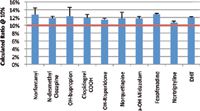Rapid, Reliable Metabolite Ratio Evaluation for MIST Assessment in Drug Discover and Preclinical Studies
Waters Corporation
The US Food and Drug Administration (FDA) recommends in their Metabolites in Safety Testing (MIST) guidelines that the safety of drug metabolites be evaluated if they are present in human plasma at concentrations greater than 10% of the parent drug (or API) at steady state. In addition, the need to rapidly evaluate multiple, diverse drug candidates and metabolites in a discovery or preclinical setting requires methodologies that are generic, fast, and robust. This application note highlights the utility of Ostro™ 96-well plates and XBridge™ BEH eXtended Performance [XP] 2.5 μm Columns for accurate metabolite ratio determination. Ten pairs of drugs and metabolites were accurately analyzed within a 2.5 min analysis time with almost no phospholipid build-up and column backpressures of less than 3500 psi, allowing the flexibility to use XP columns on any HPLC, UHPLC, or UPLC® system.
Instrumentation and Consumables
Sample Preparation: Ostro 96-well plates
Part Number: 186005518
LC Conditions
Instrument: ACQUITY UPLC® System
Column: XBridge BEH C18 XP, 2.5 μm, 2.1 × 50 mm
Part Number: 186006029
MS Conditions
Instrument: Xevo® TQ-S
Ion Source: ESI
Results and Discussion
Figure 1 shows chromatograms of 10 pairs of drugs and metabolites that were analyzed in under 1.5 min. Peak widths were under 2.5 s and the maximum column backpressure was 3500 psi. Analysis of phospholipid (PL) accumulation revealed that greater than 99% of phospholipids were eliminated compared to protein precipitation (PPT) prepared samples and PL buildup on the column was prevented.

Figure 1: 10 pairs of drugs and metabolites separated on an XBridge BEH C18, XP column.
Figure 2 shows that calculated response ratios for metabolites spiked at 10% of parent drug concentration vs. those at 100% of parent drug concentrations were within 2–3% of the theoretical ratios expected.

Figure 2: Measured response ratios for metabolites spiked at 10% vs. 100% of parent drug concentrations.
Conclusions
The generic nature of Ostro sample preparation plates makes them ideal for use in a discovery or preclinical setting where one must analyze a variety of compounds. The removal of phospholipids prevents PL accumulation on the analytical column and minimizes the risk of matrix effects due to PLs. Expected responses from analytes spiked at different concentrations are very close to theoretical targets, allowing for accurate quantification. Finally, XP columns provide excellent performance and peak capacity at backpressures that enable their use on any LC system, at analysis speeds conducive to high throughput production.
For the full application note, visit www.waters.com/4453.
© 2012 Waters Corporation. Waters, ACQUITY UPLC, Xevo, and UPLC are registered trademarks of Waters Corporation. DisQuE and XBridge are trademarks of Waters Corporation.
Waters Corporation
34 Maple Street, Milford, MA 01757
tel. (508) 478-2000; fax (508) 478-1990
Website: www.waters.com

SEC-MALS of Antibody Therapeutics—A Robust Method for In-Depth Sample Characterization
June 1st 2022Monoclonal antibodies (mAbs) are effective therapeutics for cancers, auto-immune diseases, viral infections, and other diseases. Recent developments in antibody therapeutics aim to add more specific binding regions (bi- and multi-specificity) to increase their effectiveness and/or to downsize the molecule to the specific binding regions (for example, scFv or Fab fragment) to achieve better penetration of the tissue. As the molecule gets more complex, the possible high and low molecular weight (H/LMW) impurities become more complex, too. In order to accurately analyze the various species, more advanced detection than ultraviolet (UV) is required to characterize a mAb sample.










